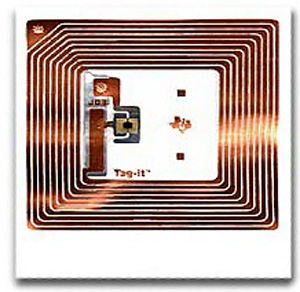Whenever the radio-frequency identification (RFID) industry is able to lower the price of tags, stores will be stocked with networks of smart packages that can track every phase of the supply chain. Shelves will be filled with smart-labeled products that can be tracked from the second you make your purchase to the moment the product hits the trash can.
Used for identifying and tracking items, an RFID system, which is made up of a small memory-storage chip (tag), is usually placed on the bottom of an item. RFID emitters send out radio waves to detect tags and read their stored data, which can range from a small serial number to several pages.

An RFID tag. Image via news.softpedia.com.
Though RFID may not be everywhere, things are quickly heading in that direction. When you walk into the local grocery store to do your weekly shopping, some of the products you regularly purchase may already be tracking your spending habits. If you buy a carton of eggs, the carton may be carrying an RFID tag, storing the eggs' expiration date and price, and product manufacturers will know that you've bought their product. Because of the tag, the store's computers will also know how many of each product need to be reordered.
In the near future, many households will be equipped with a smart refrigerator. Once you go home to put away your groceries, not only will your refrigerator be able to suggest recipes, recommend different items, and remind you of expiration dates, it will know what items you've added, as it will be equipped with a tag reader, making it capable of tracking the newly stored groceries.
Based on the products you purchase, soon enough your grocery store will be able to know your unique preferences. Instead of receiving generic newsletters about items on sale, you might receive one personally targeted at you. If you have three cats and a baby at home, your grocery store will be able to send you coupons for cat food and baby formula.
In order for this system to work, each product will be given its own product number. An Electronic Product Code (EPC) identifier, which might be well on its way to replacing the Universal Product Code (UPC), could contain 96 bits of information, including the product name, manufacturer and a 40-bit serial number. Using this system, a label could communicate with a database that would retrieve information about a product and then direct that information to the manufacturer's computers.
Though we're not quite there yet, RFID tags are already a bigger part of your life than you may realize. Aside from tracking your product choices in grocery stores and other retailers, RFID tags have been put in passports, pets and livestock, ID badges, mobile phones, car parts, and even children. Though tagging your kids with RFID tags may seem extreme to most, it appears that there's no escaping the ever-growing technology of RFID. Big Brother is always watching.
Interested in learning more about RFID technology? Visit Mouser’s RFID & NFC Technologies site.
Advertisement
Learn more about Electronic Products MagazineMouser Electronics





